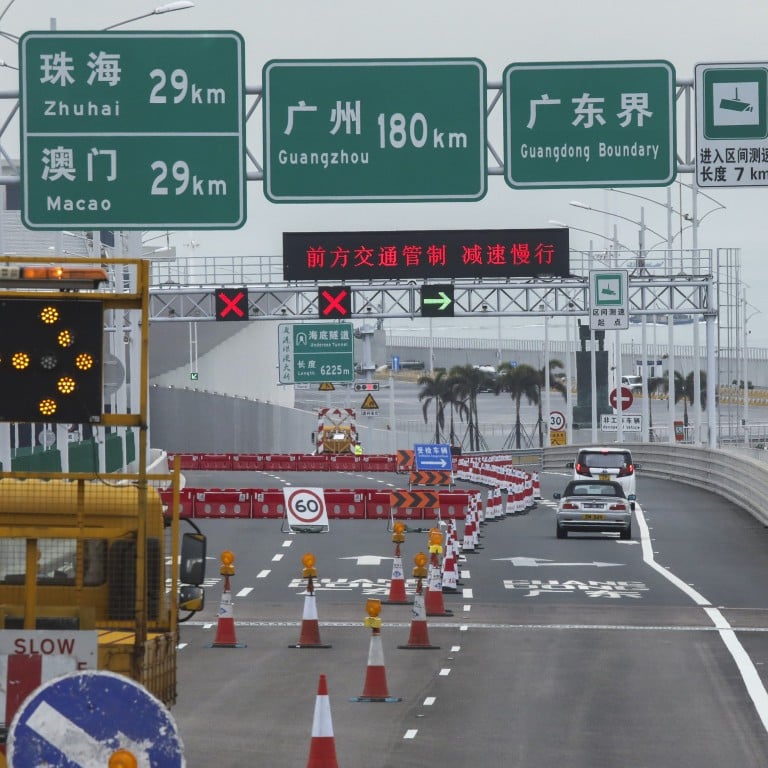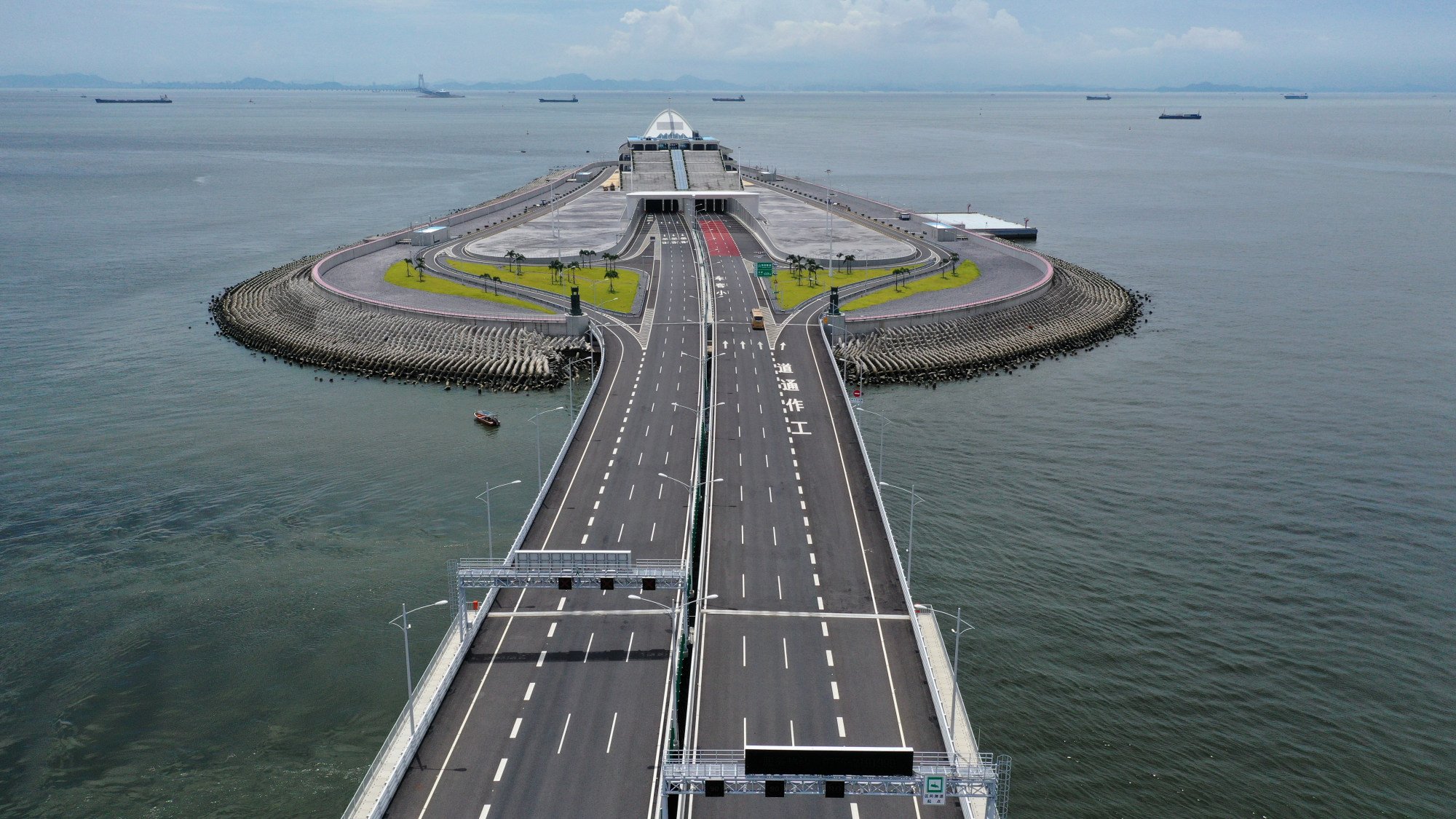
Hong Kong’s transport minister raises concerns over plan to allow drivers from Guangdong, Macau to enter city via mega bridge
- Transport chief Lam Sai-hung says several factors must be considered before scheme is implemented, such as potential strain on parking spaces and roads
- ‘The most important thing to consider is whether there should be quotas for these vehicles or designated areas for them to go to,’ he adds
Hong Kong’s transport minister has raised concerns over the potential impact of a government plan to allow drivers from Guangdong and Macau to enter the city via a mega bridge, saying no timeline has been set for the scheme yet.
Secretary for Transport and Logistics Lam Sai-hung’s expressed his reservations on Monday following earlier comments by former chief executive Leung Chun-ying, who accused authorities of being slow to implement the plan amid a stagnant economy.
Lam said a few factors had to be considered before implementing the scheme, including the relatively small size of Hong Kong and the potential strain on parking spaces and roads due to an influx of vehicles, especially in tourist-heavy areas such as Tsim Sha Tsui and both sides of Victoria Harbour.

“The most important thing to consider is whether there should be quotas for these vehicles or designated areas for them to go to,” Lam told a radio programme. “We have to take into consideration the places vehicles from mainland China would end up at.”
The minister said the government had to carefully study various factors in detail, but the difference in the position of the steering wheel in the two places would not be the main hurdle.
Mainland motorists would not need to take a test before they could drive in Hong Kong, he added.
The “Southbound Travel for Guangdong Vehicles” plan, expected to be implemented in two phases, aims to further integrate the city into the Greater Bay Area, Beijing’s initiative to integrate Hong Kong, Macau and nine mainland cities into an economic powerhouse.
Scores of Hong Kong drivers cross border for road trips under new travel scheme
The southbound plan was announced following the “Northbound Travel for Hong Kong Vehicles” scheme allowing Hongkongers to drive into Guangdong province.
Phase one of the southbound arrangement is expected to begin next year and will allow drivers of private cars from Guangdong and Macau to park at the Hong Kong-Zhuhai-Macau Bridge, before heading to the airport to catch flights or enter the city via the control point there.
Since July 1, Hong Kong private cars have been allowed to travel to Guangdong via the bridge under the northbound scheme. Residents have to apply for a permit, which is valid for up to a year.
Drivers must file an application for a cross-border driving licence and submit documents in digital format, including their vehicle registration proof, Hong Kong identity card and mainland travel permit.
What Hongkongers need to know about driving into mainland China under new scheme
Applicants also need to obtain a mainland driving licence in person in Guangdong in advance and meet insurance requirements on both sides of the border.
Zhu Yonghui, deputy director general of the Office of the Leading Group for Developing the GBA of Guangdong, on Monday said drivers from Hong Kong and Macau had made more than 1 million private car trips to the mainland since both cities’ northbound plans were launched.
Phase two of the southbound travel scheme will allow vehicles from the mainland and Macau to enter the Hong Kong’s urban areas directly.
Former chief executive Leung on Friday criticised said the government was being too slow and conservative in adopting the plan.
“Study carefully? Too worried about traffic jams? We for sure won’t have traffic jams if we are in a recession,” he said. “Ministers responsible for ‘traffic-jam-free roads’ will not be held accountable for recessions.”

Hong Kong Automobile Association honorary president Ringo Lee Yiu-pui said parking facilities at the Hong Kong-Zhuhai-Macau Bridge would need to be “massive” and accommodate 7,000 to 10,000 vehicles to prepare for the southbound plan.
“Once they have parked, [Guangdong and Macau drivers] could use Hong Kong’s mass transit to go anywhere in the city, which will not have any negative impact on traffic in Hong Kong,” he said.
Lee also suggested using the capacity of the parking facilities to determine a quota for the number of motorists allowed in under the scheme, with a cut-off limit of 80 to 90 per cent helping to create a suitable buffer.
He urged city authorities to build more car parks under the Northern Metropolis megaproject to support the southbound plan.
“The driving cultures between [Hong Kong and the mainland] are too different,” he said. “Drivers going from Hong Kong to the mainland are going from a cramped, busy environment to roomy, spacious roads with very clear satellite navigation.”
Hong Kong and Guangdong unveil website for cross-border access to public services
But mainlander drivers might struggle with the density of Hong Kong’s roads, while the city’s skyscrapers would interfere with satellite navigation, Lee added.
“Roads and tunnels might already be busy,” he said. “There will be traffic jams and they will not have parking spaces.”
The association’s honorary president said the scheme might prove unattractive to mainland motorists due to the prospect of long waiting times in traffic and other related inconveniences.
Lee also suggested that Guangdong and Macau motorists should be required to get a Hong Kong driving licence before they could come to the city, in alignment with the rules for the northbound scheme.
“The insurance and laws are different between Hong Kong and the mainland, so that there will be fewer difficulties in case anything untoward were to happen,” he said.

